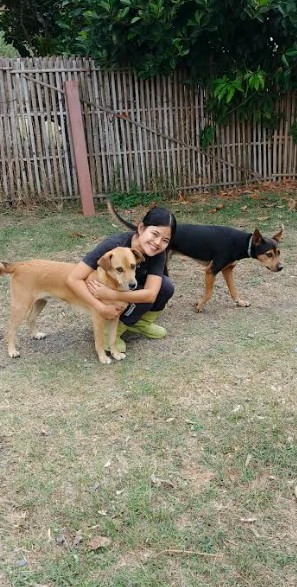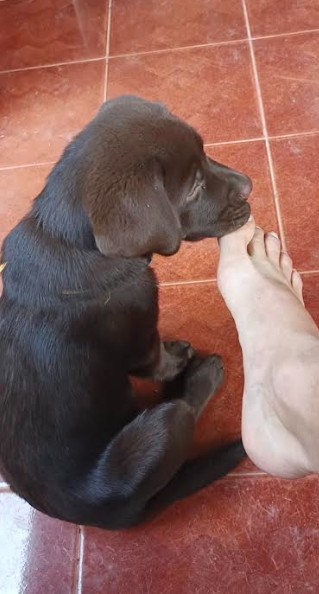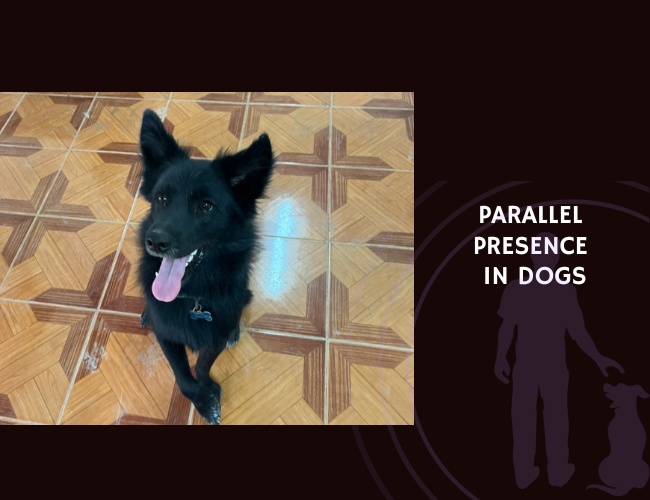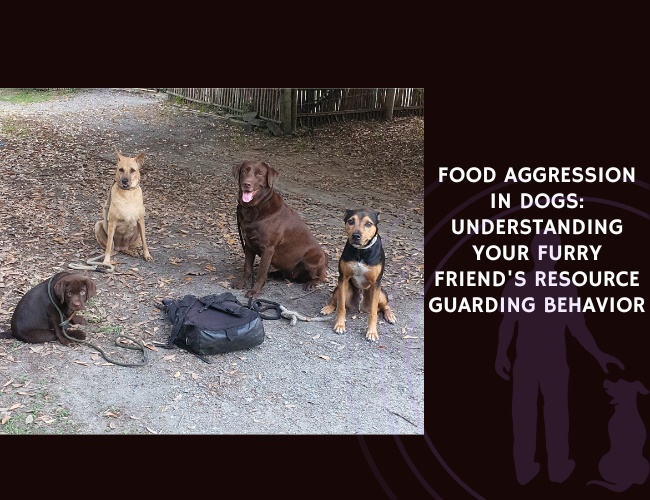Have you ever noticed how your furry friend seems to gravitate to the same room you’re in, settling down with a contented sigh just within sight? This beautiful dance of togetherness—where your dog maintains a comfortable proximity without being clingy—tells a fascinating story about the depth of your bond. Let us guide you through the science and heart of what researchers now call “parallel presence,” a remarkable phenomenon that reveals just how emotionally attuned our dogs truly are to us.
Introduction: The Silent Language of Connection
In the quiet moments of daily life, when you’re reading on the couch and your dog lies peacefully on their bed across the room, something profound is happening. This isn’t mere coincidence or simple proximity-seeking behavior—it’s a sophisticated form of emotional attunement that speaks to millions of years of co-evolution between humans and dogs. Parallel presence represents one of the most beautiful expressions of the human-canine bond, a state where both species share space, emotion, and attention without the need for constant interaction.
Unlike the anxious shadowing of a stressed dog or the demanding attention-seeking of an untrained pup, parallel presence emerges from a place of security and mutual understanding. It’s the canine equivalent of comfortable silence between old friends, where presence alone provides comfort and connection. This behavior pattern, increasingly recognized by behavioral scientists and veterinarians, offers us a window into the remarkable emotional intelligence of our four-legged companions 🧡
Character & Behavior: Understanding the Nature of Parallel Presence
What Sets Parallel Presence Apart
You might wonder how parallel presence differs from your dog simply following you around. The distinction lies in the quality of the connection and the dog’s emotional state. When your dog exhibits true parallel presence, they’re demonstrating:
Autonomous proximity – Your dog chooses to be near you but maintains their own space, perhaps settling on their favorite mat while you work at your desk. This isn’t clingy behavior; it’s a conscious choice to share your environment while respecting boundaries.
Emotional mirroring – Watch closely, and you’ll notice your dog’s energy subtly matching yours. When you’re focused on a task, they might engage in quiet self-grooming or restful observation. When you become more animated, they might stretch, shift position, or show increased alertness without necessarily seeking direct interaction.
Secure independence – Unlike dogs with separation anxiety who panic when left alone, dogs displaying parallel presence feel secure enough to engage in their own activities—chewing a toy, watching out the window, or simply resting—while maintaining that invisible thread of connection to you.
The Neurological Symphony Behind the Behavior
Recent advances in canine neuroscience reveal that parallel presence involves a complex orchestration of brain systems. The oxytocin system, often called the “love hormone” pathway, plays a starring role. When your dog maintains this comfortable proximity, both your brains are likely releasing oxytocin, creating a feedback loop of contentment and bonding. Did you know that dogs and humans are the only two species known to experience mutual oxytocin release simply from gazing at each other?
Mirror neurons, those remarkable cells that fire both when we perform an action and when we observe it in others, enable your dog to unconsciously sync with your emotional state. This neurological mechanism explains why your relaxed Sunday morning energy might find your dog sprawled contentedly nearby, while your focused work mode sees them settled but alert.
The canine social reward system also contributes significantly to parallel presence. Your mere presence activates reward centers in your dog’s brain, but—and this is crucial—in a balanced, non-addictive way when the relationship is healthy. It’s the difference between needing a fix and enjoying a pleasant experience 🐾
Vocalization & Communication: How Dogs ‘Talk’ Through Parallel Presence
The Silent Conversation
While parallel presence is largely a non-vocal phenomenon, the communication happening is rich and multifaceted. Your dog speaks volumes through:
Positional choices – Notice where your dog chooses to settle. Dogs exhibiting parallel presence often select spots that allow them to monitor your activities without being underfoot. That corner of the living room where they can see both you and the front door? That’s strategic positioning born from their desire to remain connected while fulfilling their ancestral guardian instincts.
Micro-expressions and body language – The soft eye blinks, the occasional glance your way, the way their ears track your movements even while their eyes are closed—these subtle signals maintain the emotional connection. A relaxed tail position, loose body posture, and soft facial features all indicate that your dog is in a state of calm attunement.
Breathing synchronization – In moments of deep parallel presence, you might notice your dog’s breathing rhythm beginning to match yours. This unconscious synchronization represents one of the most profound forms of non-verbal communication between species.
When Vocalizations Do Occur
While parallel presence is typically quiet, certain vocalizations can punctuate these moments:
- Contented sighs as they settle into position
- Soft groans of comfort when adjusting their posture
- Gentle “talking” sounds—those almost-whispered vocalizations some dogs make when supremely content
- Alert barks that serve to share information (“Someone’s at the door!”) rather than demand attention
These vocalizations differ markedly from anxiety-driven whining or attention-seeking barking. They’re communications of contentment and shared awareness rather than demands or distress.
Training & Education: Nurturing Parallel Presence
Building the Foundation
Parallel presence cannot be commanded or trained in the traditional sense—it must be cultivated through trust, consistency, and emotional attunement. Here’s how you can create conditions for this beautiful behavior to flourish:
Start with secure attachment – From puppyhood (or from the moment you adopt an adult dog), focus on building trust through predictable routines, gentle handling, and responsive caregiving. Dogs need to know you’re a safe haven before they can feel secure enough to maintain comfortable distance.
Practice calm together time – Set aside periods where you’re simply present together without structured interaction. Read a book while your dog rests nearby, or work on a quiet hobby while they observe. This teaches your dog that companionship doesn’t always require active engagement.
Reward settled behavior – When your dog chooses to settle near (but not on) you, occasionally offer quiet praise or a gentle touch. This reinforces their choice without creating excitement or dependency.
Advanced Cultivation Techniques
For dogs who struggle with parallel presence—whether due to anxiety, hyperattachment, or past trauma—these approaches can help:
Graduated proximity training – Start with very short periods of calm togetherness, gradually extending the duration. If your dog struggles to settle, begin with just 30 seconds of quiet companionship before releasing them to play or explore.
Mat training with a twist – Teach your dog to relax on a specific mat or bed, but practice this in various locations relative to where you’re sitting. This builds their confidence in settling at different distances while maintaining connection.
Synchronized breathing exercises – Consciously slow your breathing when your dog is near. Many dogs will unconsciously match your rhythm, deepening their state of relaxation and attunement.
Performance & Activities: Parallel Presence in Action
During Daily Routines
Parallel presence shines most clearly during everyday activities. You might notice your dog:
- Lying in the kitchen doorway while you cook, positioned to observe without interfering
- Settling under your desk during work hours, occasionally shifting position as you do
- Moving from room to room with you throughout the day, always finding their own spot to settle
- Maintaining a watchful but relaxed presence during your exercise routines
This behavior adapts beautifully to different contexts. During high-energy activities, your dog might maintain greater distance while still keeping you in sight. During quiet evening routines, they might settle closer, their proximity inversely related to your activity level.
In Multi-Dog Households
Parallel presence becomes even more fascinating in homes with multiple dogs. You might observe:
Layered proximity – Dogs arranging themselves at different distances from you, each finding their comfortable zone while respecting others’ space.
Emotional contagion – One dog’s calm parallel presence can influence others to settle similarly, creating a peaceful group dynamic.
Individual preferences – Each dog may express parallel presence differently based on their personality, with some preferring closer proximity and others maintaining greater distance while still participating in the group energy.
During Outdoor Adventures
Parallel presence extends beyond the home:
- On hiking trails, dogs with strong parallel presence often range ahead or behind while frequently “checking in” visually
- At dog parks, they might explore independently while maintaining awareness of your location
- During camping trips, they naturally position themselves between you and the periphery of your campsite, balancing exploration with protective presence

Nutritional Recommendations: Feeding the Calm, Connected Dog
The Gut-Brain Connection
Believe it or not, nutrition plays a role in your dog’s ability to maintain the calm, attuned state necessary for parallel presence. The gut-brain axis—that bidirectional communication highway between digestive system and nervous system—influences mood, anxiety levels, and social behavior.
Balanced protein levels – While protein is essential, excessive amounts can lead to hyperactivity in some dogs. Aim for high-quality protein sources at appropriate levels for your dog’s age and activity level. Dogs exhibiting beautiful parallel presence often thrive on moderate protein levels (22-26% for most adult dogs).
Omega-3 fatty acids – These essential fats support neurological health and can help maintain the calm, focused state conducive to parallel presence. Consider supplements or foods rich in EPA and DHA, such as fish oil or algae-based alternatives.
Complex carbohydrates – Despite the trend toward grain-free diets, many dogs benefit from the steady energy provided by complex carbohydrates. These can help maintain stable blood sugar levels, supporting emotional regulation throughout the day.
Feeding Routines That Support Connection
How you feed matters as much as what you feed:
Predictable meal times – Regular feeding schedules support the security and routine that underpin parallel presence. Dogs who know when meals arrive feel less anxious about resources.
Calm feeding environments – Create peaceful mealtimes free from competition or stress. This carries over into their general state of being throughout the day.
Mindful treat giving – Use treats to reinforce calm, settled behavior rather than excitement. A small reward delivered quietly when your dog chooses appropriate proximity can strengthen parallel presence patterns.
Health Concerns: When Parallel Presence Patterns Change
Reading the Signs
Changes in your dog’s parallel presence behavior can signal underlying health issues. Pay attention if you notice:
Increased clinginess – A dog who suddenly won’t leave your side might be experiencing pain, vision loss, or cognitive decline. This represents a shift from healthy parallel presence to anxiety-driven proximity seeking.
Decreased connection – If your typically attentive dog becomes distant or stops maintaining proximity, consider potential causes like:
- Hormonal imbalances (thyroid issues are common culprits)
- Chronic pain leading to irritability or withdrawal
- Sensory decline making it harder to track your movements
- Gastrointestinal discomfort affecting overall wellbeing
Disrupted patterns – Dogs who pace instead of settling, or who seem unable to find comfortable positions near you, might be experiencing:
- Cognitive dysfunction syndrome (canine dementia)
- Anxiety disorders requiring veterinary intervention
- Musculoskeletal issues making rest uncomfortable
Supporting Health Through Connection
Regular veterinary checkups become even more important when you understand parallel presence as a barometer of wellbeing. Discuss any changes in your dog’s proximity patterns with your vet, as these subtle behavioral shifts often precede more obvious symptoms.
Consider these health-supporting practices:
- Joint supplements for senior dogs to maintain comfortable positioning
- Environmental modifications (orthopedic beds, non-slip rugs) to support physical comfort
- Cognitive enrichment activities to maintain mental sharpness
- Stress-reduction protocols for anxious dogs
Still. Seen. Synchronized.
Parallel presence is quiet proof of love.
When your dog settles across the room—not needing touch, only nearness—it reflects a bond rooted in trust, not dependence. This unspoken togetherness is emotional fluency made visible.
Your calm becomes their calm.
Through mirror neurons and co-regulation, your dog syncs to your state. Whether you’re working, reading, or simply breathing slowly, their body listens—adjusting, matching, and mirroring your energy without demand.



True connection doesn’t chase—it coexists.
Parallel presence isn’t trained—it’s allowed. It grows where safety, space, and mutual respect shape the atmosphere. And when it appears, it’s not a trick—it’s a shared state of peace.
Lifestyle & Environment: Creating Spaces for Connection
Designing Your Home for Parallel Presence
Your living space profoundly influences your dog’s ability to maintain comfortable proximity. Consider these environmental factors:
Multiple settling spots – Provide comfortable resting areas in each room where you spend time. This might include:
- A bed in your home office positioned where your dog can see you without being underfoot
- A mat in the kitchen placed safely away from cooking areas but within view
- Cozy spots near (but not directly next to) your favorite reading chair
Clear sightlines – Dogs maintaining parallel presence often prefer positions where they can easily monitor your activities. Arrange furniture to create these natural observation points.
Temperature comfort – Ensure various microclimates in your home. Some dogs prefer cooler tile floors, while others seek warm, carpeted areas. Options allow your dog to regulate their comfort while maintaining proximity.
Managing Modern Life Challenges
Contemporary lifestyles can challenge parallel presence:
Work-from-home dynamics – The increase in remote work means more time with our dogs, but also more potential for boundary confusion. Establish clear patterns:
- Designated “working” vs “available” signals your dog can learn
- Regular breaks that include brief, calm interactions
- Consistent routines that help your dog predict your availability
Technology distractions – Our devices can interfere with the subtle attunement required for parallel presence. Practice mindful phone-free time to deepen your connection.
Multi-person households – Dogs may show different parallel presence patterns with different family members. This is normal and reflects individual relationship dynamics.
Senior Care: Parallel Presence in the Golden Years
Adapting to Changing Needs
As dogs age, their expression of parallel presence often evolves. Senior dogs might:
Seek closer proximity – Declining senses may lead older dogs to stay nearer to feel secure. This isn’t regression but rather adaptive behavior.
Need more support – Cognitive changes can affect a senior dog’s ability to maintain the calm state required for parallel presence. Extra patience and environmental support become crucial.
Show time-of-day variations – Many senior dogs experience “sundowners syndrome,” becoming more anxious in the evening. Their parallel presence patterns may be strongest during morning and afternoon hours.
Maintaining Connection Through Changes
Supporting parallel presence in senior dogs requires:
- More frequent, gentler check-ins throughout the day
- Environmental modifications to accommodate mobility limitations
- Patience with increased vocalization or need for reassurance
- Recognition that quality of connection matters more than perfect behavior patterns
The beauty of parallel presence is that it can adapt and persist even as our dogs’ physical and cognitive abilities change. The emotional core of the connection remains, even if its expression shifts 🧡
Advanced Understanding: The Science Behind the Bond
Evolutionary Perspectives
The capacity for parallel presence likely emerged through domestication. Unlike their wolf ancestors, who maintain proximity for survival and hunting coordination, dogs developed this more nuanced form of companionship. This evolutionary journey selected for dogs who could:
- Read human emotional states with remarkable accuracy
- Regulate their own arousal to match human household rhythms
- Find intrinsic reward in simple proximity without constant interaction
- Balance independence with connection
Cultural and Breed Variations
Different breeds may express parallel presence in characteristic ways:
Herding breeds often maintain wider proximity circles, their parallel presence including periodic “check-ins” as they would with a flock.
Guardian breeds might position themselves strategically between you and entrance points, their parallel presence including a protective element.
Companion breeds may prefer closer proximity, their parallel presence expressed through near-constant visual contact.
Hounds might seem less connected but often maintain awareness through their exceptional hearing, their parallel presence more subtle but equally real.
Measuring the Immeasurable
Researchers studying parallel presence use sophisticated tools:
- GPS and proximity sensors track movement patterns and preferred distances
- Heart rate variability monitors reveal states of calm co-regulation
- Cortisol testing shows reduced stress in dogs exhibiting healthy parallel presence
- Behavioral coding systems quantify the subtle signs of attunement
These scientific approaches validate what dog lovers have long known intuitively—the connection we share with our dogs transcends simple training or proximity.
Troubleshooting Common Challenges
When Parallel Presence Doesn’t Develop
Some dogs struggle to achieve healthy parallel presence due to:
Early life experiences – Puppies who missed critical socialization or experienced trauma may need extra support developing secure attachment patterns.
Genetic predispositions – Some dogs are naturally more independent or anxious, requiring modified approaches to connection.
Previous training methods – Dogs trained with heavy correction or excessive control may struggle to relax into natural proximity patterns.
Environmental stressors – Chaotic households, frequent moves, or inconsistent routines can interfere with the security needed for parallel presence.
Building Bridges for Struggling Dogs
For dogs who haven’t yet developed parallel presence, consider:
Therapeutic interventions – Certified behavioral consultants can help address underlying anxiety or attachment issues.
Gradual desensitization – Slowly building positive associations with calm proximity through systematic training.
Environmental management – Creating predictable, low-stress conditions that allow natural behaviors to emerge.
Patience and time – Some dogs, particularly rescues with unknown histories, need months or even years to develop secure attachment patterns.
The Broader Impact: How Parallel Presence Enriches Our Lives
Benefits for Humans
Living with a dog who exhibits healthy parallel presence offers profound benefits:
- Reduced stress through non-demanding companionship
- Increased productivity when working from home
- Enhanced emotional regulation through co-regulation
- Deeper appreciation for non-verbal communication
- Modeling of healthy attachment and boundaries
Strengthening the Human-Animal Bond
Parallel presence represents one of the purest forms of interspecies relationship—a connection based not on control or dependence but on mutual choice and emotional attunement. This behavior pattern shows us that:
- True companionship doesn’t require constant interaction
- Security allows for healthy independence
- Emotional connection transcends species boundaries
- The best relationships balance togetherness and autonomy
Conclusion: Is Parallel Presence Right for You and Your Dog?
As we’ve explored throughout this guide, parallel presence isn’t just a behavior—it’s a window into the remarkable emotional world of our canine companions. If you’re wondering whether to cultivate this beautiful form of connection with your dog, consider these questions:
- Do you value companionship that respects both your needs and your dog’s?
- Can you appreciate the subtle, quiet moments of connection as much as active play?
- Are you willing to build the trust and security that allows this behavior to flourish naturally?
- Do you have the patience to let this relationship dynamic develop over time?
If you answered yes to these questions, you’re ready to embark on the journey of fostering parallel presence with your furry friend. Remember, this isn’t about training a behavior—it’s about creating conditions where your dog’s natural capacity for emotional attunement can flourish.
The path to parallel presence is paved with patience, consistency, and genuine emotional availability. Some days will be easier than others, and every dog will express this connection in their own unique way. What matters is the journey itself—those quiet moments of shared presence that remind us why the human-canine bond is unlike any other relationship in our lives.
As you move forward, pay attention to the small moments: the contented sigh as your dog settles nearby, the gentle check-in glance across the room, the way their breathing slows to match yours during quiet evenings. These are the building blocks of parallel presence, and they’re available to every dog-human pair willing to cultivate them.
Next, we encourage you to observe your own dog with fresh eyes. Notice their proximity patterns, their settling behaviors, their unique ways of maintaining connection. In understanding parallel presence, you’re not just learning about a behavior—you’re deepening your appreciation for the profound emotional intelligence of the friend who shares your home and heart 🐾
Whether your dog already demonstrates beautiful parallel presence or you’re just beginning to nurture this connection, remember that every relationship is unique. Trust the process, celebrate small victories, and above all, enjoy the remarkable gift of sharing your life with a being capable of such sophisticated emotional connection. In a world that often demands constant interaction and stimulation, parallel presence reminds us that sometimes the deepest connections happen in the quiet spaces between us.
We see them walk by every day. The dogs tell the story. The rest is just noise.










